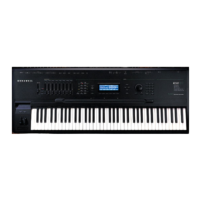Program Edit Mode
Arpeggiator Page
3-17
Here’s a very simple example. Suppose that the only note in the Arpeggiator cycle isC4,
Shift Amount is4 (a third), and Shift Limit is7 (so notes won’t get shifted above G4). e
Arpeggiator plays C4, then E4. e next note should be G
#
4, but that’s above the shift
limit—so the Arpeggiator calculates the dierence between that G
#
4 and the shift limit (G4):
one semitone. It adds that dierence to the original starting note (C4) and plays that note
next—C
#
4. e next note (F4) is within the shift limit, but the next note (A4) isn’t, so it gets
translated into D4—and so on.
FloatUnip uses the same concept as FloatRst and applies it to Unipolar mode: when the
Arpeggiator reaches the shift limit, it calculates the dierence between the next note and
the limit, and transposes the next cycle of notes down by that interval, then shifts each
subsequent cycle down until it reaches the original pitch.
FloatBip is similar to FloatUnip, but the downward shift limit isn’t the original pitch, it’s the
negative of the Shift Limit value.
Key Range (Low Key and High Key)
e Arpeggiator processes notes within the range of these parameters. Notes outside the
specied range play normally, and do not become part of the arpeggiation sequence. When
the Low Key or High Key parameter is selected, you can easily set the value by holding the
ENTER button and striking the desired key. Key Range is not saved with each Arp Preset,
but instead is saved as part of each program (or Multi Zone). is allows you to try dierent
presets while maintaining the same Key Range.
Arpeggiator Classic Mode Parameters
Beats
e Beats parameter sets the number of notes per beat. e tempo is based on quarter notes.
erefore, if you set Beats to 1/4, you will get one note per beat of the clock. At 1/16, you
will get 4notes per beat, and so forth. e maximum value is 96 notes per beat (1/384), but
at most tempos, divisions smaller than 1/64 will sound pretty much the same.
To nd a Beats value, multiply the notes you want per beat by 4. For example, 4 notes per
beat (16th notes) would be 4*4=16, a Beats value of 1/16. ree notes per beat (8th note
triplets) would be 3*4=12, a Beats value of 1/12. Six notes per beat (16th note triplets)
would be 6*4=24, a Beats value of 1/24.

